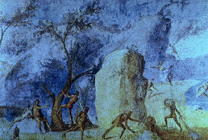

 Whenever we look at a flat surface (a picture, a television screen) and assume
we are looking at spaces and objects that have depth, we are accepting a set
of visual signals that create an illusion of three dimensional space.
3D cues are so common today that we are almost unaware of them. However, these
signals were not always used and understood; even today in some preliterate
societies, people may have difficulty understanding 3D illusions. Understanding
how these illusions work is a key to developing our ability to think spatially.
Spatial concepts come into play whether we are trying to find our way through
the streets of a strange town, figure out how to wrap cloth around a body to
achieve a fashion idea, envision the inner structures of a complex mechanism
or body part, or simply do an accurate drawing of what we see.
Whenever we look at a flat surface (a picture, a television screen) and assume
we are looking at spaces and objects that have depth, we are accepting a set
of visual signals that create an illusion of three dimensional space.
3D cues are so common today that we are almost unaware of them. However, these
signals were not always used and understood; even today in some preliterate
societies, people may have difficulty understanding 3D illusions. Understanding
how these illusions work is a key to developing our ability to think spatially.
Spatial concepts come into play whether we are trying to find our way through
the streets of a strange town, figure out how to wrap cloth around a body to
achieve a fashion idea, envision the inner structures of a complex mechanism
or body part, or simply do an accurate drawing of what we see.
 The ancient Romans had the ability to depict depth in their paintings. However
during the Middle Ages European artists lost the skill of depicting three dimensional
illusions accurately. Indeed, this kind of realism was not important for the
purposes of
The ancient Romans had the ability to depict depth in their paintings. However
during the Middle Ages European artists lost the skill of depicting three dimensional
illusions accurately. Indeed, this kind of realism was not important for the
purposes of  visual images in the early Christian era, when figures and landscapes were intended
as a kind of generic shorthand for the religious and historical stories being
told. Realistic copies of the material world were not valued; instead, stylized
symbols of historical and religious subjects were desired, executed in a strictly
traditional way that could be easily recognized by a devout, but illiterate,
public. As a result, Medieval images like this one were generally flat in appearance,
or gave mixed signals about the three dimensional space depicted.
visual images in the early Christian era, when figures and landscapes were intended
as a kind of generic shorthand for the religious and historical stories being
told. Realistic copies of the material world were not valued; instead, stylized
symbols of historical and religious subjects were desired, executed in a strictly
traditional way that could be easily recognized by a devout, but illiterate,
public. As a result, Medieval images like this one were generally flat in appearance,
or gave mixed signals about the three dimensional space depicted.
 All this changed in the late 15th century, when architects and artists discovered
the value and power of three dimensional effects in drawing and painting. This
blended with the intellectual explorations of the period, in which truth, realism,
and individuality were prized. Three dimensional effects were greeted as a sensational,
almost magical illusion that made painting into a kind of magic window into
a very believable world. The paintings of Raphael are dramatic examples of the
Renaissance fascination with this new bag of tricks. For further information on the history of
linear perspective, go to this site and click on
Early_history of perspective.
All this changed in the late 15th century, when architects and artists discovered
the value and power of three dimensional effects in drawing and painting. This
blended with the intellectual explorations of the period, in which truth, realism,
and individuality were prized. Three dimensional effects were greeted as a sensational,
almost magical illusion that made painting into a kind of magic window into
a very believable world. The paintings of Raphael are dramatic examples of the
Renaissance fascination with this new bag of tricks. For further information on the history of
linear perspective, go to this site and click on
Early_history of perspective.
The tools for creating illusions of three dimensional space are overlapping, changing size and placement, linear perspective, relative hue and value, and atmospheric perspective.
The simplest tool for indicating three dimensional space is overlapping.
The effect is accomplished by allowing the contour of one form to be interrupted
by the contour of another form, so that one supersedes the other. This device
can be seen in this Byzantine mosaic as virtually the only spatial cue. The
overall composition appears to be quite flat, with only the subtle signal of
the overlapping of garments to tell us who is in front and who is farther back.
The effect is as if all the people are crowded up against the "window" of the
picture- a very flat effect.
The next level of spatial signals is provided by
changing size and placement. Placement alone was
used earlier, but until changing size was added, the illusion was less
than fully convincing, at least to modern eyes.
The greatest leap forward in the representation of three dimensional space occurred
in the 15th century, with the discovery of linear perspective. Linear perspective
refers to the illusion that objects appear to grow smaller and converge toward a "vanishing point"
at the horizon line. The point of convergence may be in any direction the viewer looks, including up,
and the horizon/ vanishing point may be visible or imaginary. Paying attention to the shapes of objects
in relation to their placement is essential to linear perspective. The rate at which forms appear to
change in size and placement is regular, and mathematically predictable. The form (for example, a cube)
must also be distorted to suggest perspective. These mathematical discoveries
were closely linked to architecture, but also led to a startling new level of
realism in drawing, that became the great passion of renaissance artists. In
turn, the illusions of linear perspective in drawing led to the creation of innovative
spatial effects in architecture.You can go to for
a demonstration of linear perspective; or try this link
to an interactive example.
Hue and value are very important cues that tell us whether
an object is near or far. In general, we tend to read warm hues as being closer
that cool hues.
We also see colors that are close in value as being close to each other in space,
but colors that have strong contrast in value appear to separate in space. Distant
objects tend to be either similar or neutral in value, and desaturated in hue.
Close objects tend to exhibit stronger, more saturated hues, and/or more contrasting
values, including extremes of dark and light. In the landscape shown here, the
strongest hue and value contrasts occur where the trees overlap the lake; the
trees and sky beyond the lake are no doubt similar in color, but appear to be
more neutral in value and desaturated in hue, with less contrast. Also, the
warm colors of the leaves in the foreground pull forward, while the cooler colors
of the farther shore and the sky tend to recede in distance.
Atmospheric perspective combines several features described
above. It operates when objects placed in the upper half of the page, and understood
to be far away, lack contrast, detail, and texture. In this painting by Hieronymus
Bosch, the upper quarter of the page tends to show less contrast and detail.
Not only do the most distant objects tend to be in the upper half of your field
of vision, areas intended to be shown as distant will be neither extremely dark
or light in value, nor be brightly colored (intense in hue). On the other hand,
detail, texture, and hue and value contrast are more likely to appear in the lower
half of the picture plane, as they do here.
These qualities are used in combination, as they are in this painting. If any of these concepts is ignored or intentionally set at odds with the others, it interferes with the three dimensional illusion. Here, overlapping, relative size and placement, linear perspective, hue, value, and atmospheric perspective work together to create an illusion of great distance.
It is also possible to break all of these rules purposely in order to create three dimensional illusions that can fool the viewer and/or could never exist in an actual three dimensional model. (Some of the images in this linked site relate to color concepts we will discuss later, not just to spatial concepts)In Chinese art, however, the rules applied to creation of perspective are simply different. Often referred to as "floating Perspective,"in this approach as the viewer's point of view shifts from "near" to "far" parts of the image, the linear perspective point of view also shifts (see this example of floating perspective in Chinese landscape painting..
Other designed objects such as furniture, tools, and appliances must be
conceived in relation to function and, often, the contours of the human body
that will use the object. Fashion designers face special problems of
engineering and spatial thinking, in that the problem is to translate a two
dimensional material (cloth) into a three dimensional form (body-shaped
garment)-- a unique and complex problem in topographical engineering.
Three dimensional shape has an expressive vocabulary similar to that of
line This obviously follows, since line is always implied by the contours of shapes. For example, rectilinear shapes
suggest stability.
Angular shapes placed diagonally in relation to
gravity suggest instability.
Shapes that exhibit softly curving surfaces
suggest quiet, comfort, and sensuality.
 |